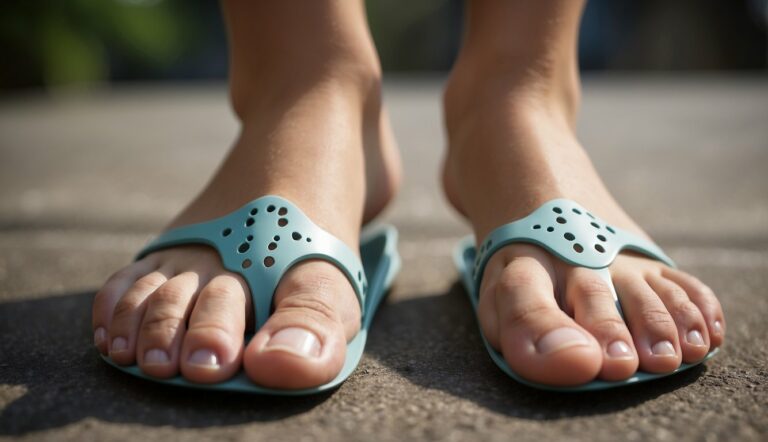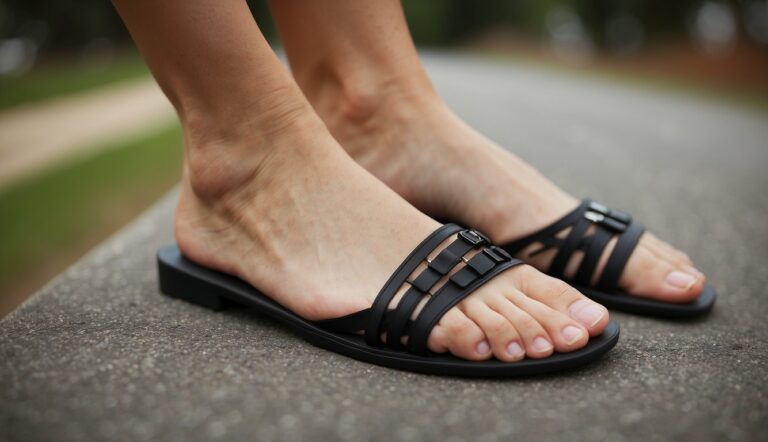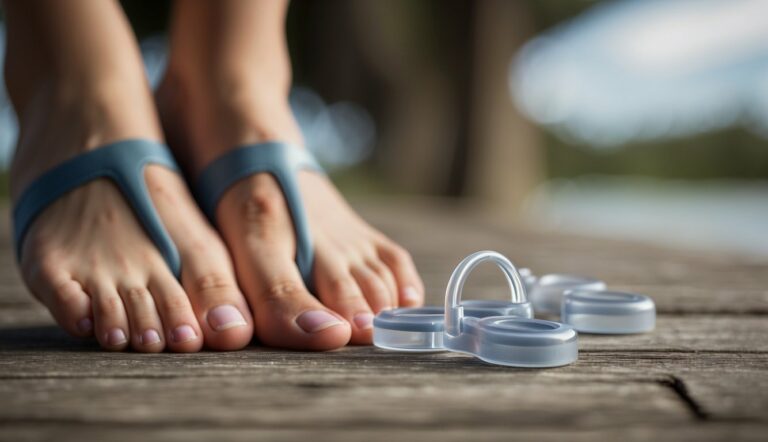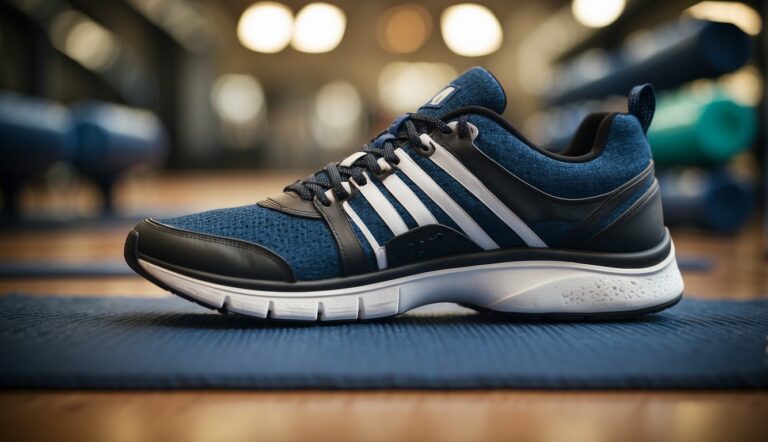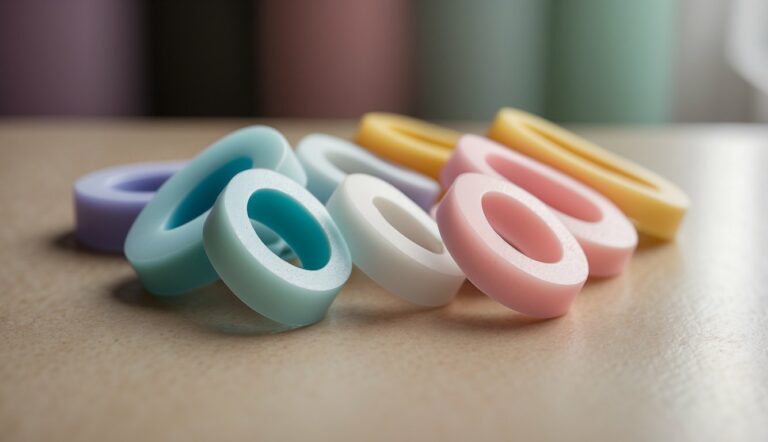How Toe Spacers Can Help with Neuropathy: Examining the Potential Benefits
Neuropathy, a condition characterized by nerve damage, often leads to symptoms like pain, tingling, and numbness in the feet. As an expert in foot care, I find that maintaining proper toe alignment is crucial for foot health. Toe spacers are a non-invasive tool that can be particularly beneficial for those with neuropathy, as they promote proper toe alignment and reduce pressure on the nerves.
Toe spacers work by gently separating the toes, encouraging them to spread out to their natural position. This can improve circulation in the feet, a significant factor in managing neuropathy symptoms. They also help in reducing the risk of toe overlap, corns, and bunions, which can exacerbate discomfort for neuropathy sufferers.
Incorporating toe spacers into your foot care routine may help alleviate some neuropathy symptoms by allowing feet to relax and spread out, potentially reducing nerve compression. While they are not a cure for neuropathy, they are a simple, supportive measure that can be easily integrated with other treatment approaches recommended by healthcare professionals.
Neuropathy and the Role of Toe Spacers
In this section, we’ll explore how neuropathy develops, the purpose of toe spacers, and their specific role in providing comfort for those experiencing neuropathy.
The Basics of Neuropathy
Neuropathy refers to damage or dysfunction of one or more nerves, often leading to numbness, tingling, muscle weakness, and pain in the affected area. Diabetic neuropathy is a common type, affecting the feet’s sensory and motor nerves. It can cause changes in sensation, which might lead to pressure points and foot deformities.
How Toe Spacers Work
Toe spacers are devices made typically of silicone or gel that fit between the toes to maintain proper alignment and spacing. By doing so, they reduce pressure on the toes and can improve foot function. Improved toe alignment can lead to better weight distribution when standing or walking, which is crucial for overall foot health.
- Benefits:
- Maintain toe alignment
- Reduce pressure on adjacent toes
- Improve weight distribution

The Connection Between Toe Spacers and Neuropathy
The use of toe spacers can be particularly beneficial for people with neuropathy, as they may help alleviate overlapping or crowding of toes, a common issue that can lead to discomfort and skin breakdown. By encouraging proper toe alignment, toe spacers can enhance blood flow and potentially reduce the risk of complications associated with neuropathy like ulcers and calluses.
- Potential Benefits for Neuropathy:
- Enhanced comfort and reduced pain
- Prevention of skin breakdown
- Improved circulation through proper foot alignment
While toe spacers can be a helpful tool in managing the symptoms of neuropathy, it’s important to consult with a healthcare professional before starting any new treatment regimen.
Benefits of Toe Spacers for Foot Conditions like Neuropathy
Toe spacers are designed to address several common foot conditions effectively. By realigning toes to their natural position, they offer both immediate relief in some cases and potential long-term benefits, particularly for conditions like bunions, hammertoes, and plantar fasciitis.
Alleviating Bunions and Hammertoes
Bunions (Hallux Valgus):
- Theory: Applying gentle pressure to realign the big toe.
- Result: May reduce pain and improve toe alignment over time.
Hammertoes:
- Use: Regular spacer usage can keep toe joints flexible.
- Outcome: Potentially prevent the rigid contracture of hammertoes.
Aiding Plantar Fasciitis and Flat Feet
Plantar Fasciitis:
- Strategy: Creates a better foot foundation which may reduce strain on the plantar fascia.
- Benefit: Could provide symptomatic relief and aid in recovery.
Flat Feet:
- Application: Encourages a more natural arch by spacing toes.
- Advantage: Supports the muscle structures and could improve foot mechanics.
Improving Overall Foot Health
Toe Deformities & Foot Deformities:
- Method: Gently encourages toes into a more optimal position.
- Effect: Can lead to a healthier foot structure and improved balance.
Foot Health:
- Action: Maintains proper toe alignment, which may enhance circulation and foot strength.
- Impact: Overall improvements in foot health and reduced likelihood of related issues.
Daily Use and Activities
Incorporating toe spacers into daily life can enhance foot health by improving balance, stability, and mobility. This is particularly beneficial for athletes or those engaged in regular physical activity.
Toe Spacer Use During Physical Activity
When I engage in physical activity, I find that toe spacers can be quite helpful. They are designed to realign my toes, allowing for better weight distribution across my feet. This promotes improved balance and stability, which are crucial for high-impact exercises and athletic performance. For instance, while doing balance-focused exercises like standing on one leg, toe spacers can provide the added stability needed to maintain proper posture. When incorporating toe spacers during workouts or stretching routines, I often notice a positive difference in how my feet feel and perform.
- Balance-enhancing exercises with toe spacers:
- Standing on one leg: Helps build stability in the foot muscles.
- Toe taps and lifts: Encourages mobility and control in my toe joints.
- Heel-to-toe walk: Aids in the improvement of overall balance and coordination.
By integrating toe spacers into these activities, I can work towards reducing the risk of injury and enhancing my athletic performance.
Incorporating Toe Spacers in Daily Routines
I integrate toe spacers into my daily routine to help maintain foot health and aid in managing neuropathy symptoms. Simple activities like walking can be more comfortable as the spacers gently separate my toes, reducing the pressure and friction between them. When I use toe spacers consistently, it is not just during exercise but also when I’m at rest, such as sitting or lying down. This regular use supports the natural alignment of my toes, contributing to improved overall foot function.
For individuals seeking to use toe spacers as part of their daily activities, I recommend starting with short durations and gradually increasing the time worn as the feet adjust:
- Daily toe spacer schedule:
- Morning: Wear for 10-15 minutes while getting ready.
- Daytime: Use for short walks or seated activities.
- Evening: Implement during relaxation time or before bed.
This incremental approach helps the feet become accustomed to the spacers and can make a noticeable difference in comfort and foot health over time.
Design and Material Choices for Toe Spacers
When selecting toe spacers for neuropathy, it’s crucial to consider both the material and design as they directly affect the device’s comfort and functionality.
Evaluating Different Materials
Silicone: Flexible and soft, silicone toe spacers easily conform to the foot’s anatomy, making them a popular choice for those suffering from neuropathy. Their hypoallergenic nature ensures minimal risk of irritation.
Gel: Gel-based spacers provide a cushioning effect helpful for sensitive feet. They tend to be stickier than silicone, which helps them stay in place, but may require more frequent cleaning.
Foam: Foam spacers are lightweight and can offer a gentle separation between toes. However, they may not provide as much structural support as silicone or gel and might compress over time.
Effectiveness of Various Designs
Brands like Earth Runners and Awesome Toes offer different design philosophies that target alignment and spreading of the toes to alleviate discomfort. The effectiveness of a toe spacer’s design often comes down to how well it accommodates individual foot shapes and addresses specific neuropathic symptoms.
Toe Loop Design: Some spacers feature loops that hold each toe, enhancing alignment and stability, which can be particularly beneficial for neuropathy patients who require secure positioning of their toes to prevent nerve irritation.
Full-Spread Design: Designs that spread all the toes apart evenly can prevent overlapping and encourage proper joint alignment, potentially reducing neuropathy-related pain due to nerve compression.
Practical Considerations and Recommendations
When considering toe spacers for neuropathy, it’s essential to focus on the right fit, expert consultation, and proper care for long-term benefits. Here are practical steps to ensure the effectiveness of toe spacers, aiming to enhance comfort and potentially alleviate foot pain.
Choosing the Right Toe Spacer
I recommend selecting toe spacers that provide a comfortable stretch without causing additional pain. Look for spacers made of soft, flexible materials such as silicone, which can accommodate different toe sizes while maintaining the toes in proper alignment. When choosing a toe spacer, consider the following:
- Material: Opt for non-toxic and hypoallergenic materials that are gentle on the skin.
- Size: Ensure the spacers fit snugly but don’t constrict toes too tightly, as this can worsen neuropathy symptoms.
- Design: Some toe spacers come with added support for specific conditions, such as bunions. Choose a design that targets your particular needs.
Consulting with Podiatrists
Before starting, it’s crucial to consult with a podiatrist, especially if you have an existing foot injury or severe pain. A podiatrist can offer personalized advice on toe spacing and recommend an appropriate regimen to strengthen foot muscles. They may also suggest combining toe spacers with other treatments or specific footwear to maximize the benefits and avoid further injury.
Long-Term Use and Maintenance
Consistency and proper maintenance are key for potentially benefiting from toe spacers:
- Routine: Incorporate toe spacing into your daily routine for gradual improvement in toe alignment and foot strength.
- Hygiene: Clean your toe spacers regularly to prevent any infections, especially important for those with neuropathy, since they may have reduced sensation in their feet.
- Assessment: Monitor your feet for any signs of discomfort or adverse reactions. Adjust the frequency and duration of use accordingly, and consult a podiatrist if issues arise.
By adhering to these practical considerations and recommendations, you may find improved comfort and support for neuropathic foot pain. Remember, it’s not a one-size-fits-all solution—personalization and professional guidance are important steps toward finding relief.
